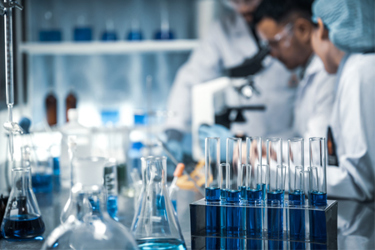Optimizing AAV8 Capsid Purification With Oversized GOI: Efficient Separation Of Empty, Partial, And Full Capsids Using Anion Exchange Chromatography
By Yeonji Kim, Chris Brown, Jing Zhu, and Xiaojun Liu*

Adeno-associated virus (AAV) vectors are widely used in gene therapy, but the production process often yields heterogeneous populations of viral particles, including empty capsids (lacking a genome), partially filled capsids (containing fragmented DNA), and full capsids (encapsulating an intact genome). Empty capsids, classified as product-related impurities, lack the therapeutic gene of interest and are devoid of functional relevance. While their precise role remains unclear, studies suggest they may influence therapeutic efficacy and safety profiles or act as decoys for neutralizing antibodies. Consequently, effective separation of empty capsids is critical to ensure a high-quality AAV product (Zhu et al., 2025)
Anion exchange chromatography (AEX) has emerged as the preferred method for large-scale separation of AAV capsids due to its scalability, reproducibility, and ability to maintain vector integrity. Recipharm Advanced Bio's platform AEX process demonstrated high-resolution separation, achieving greater than 90% full capsid purity with minimal loss of vector potency. In this study, we aim to achieve the same with large sized GOI (>4.9 kb) by systematically evaluating AEX as a platform for oversized AAV8 capsid separation.
Critical factors, including buffer composition, were systematically investigated to achieve optimal separation. Trivalent sodium phosphate (PO₄³⁻) was selected over monovalent and divalent salts, such as sodium chloride and sodium sulfate, due to its superior resolution power. This advantage is likely attributed to its higher ionic and displacement strength, enabling more precise differentiation between empty, partial, and full AAV8 capsids (Joshi et al., 2021). Analytical methods such as mass photometry, Analytical ultracentrifugation (AUC), and droplet digital PCR (ddPCR) were employed to assess capsid content and DNA encapsulation efficiency. The study also compared partial capsid separation across different conditions to ensure accurate quantification and removal of intermediates.
These findings provide a robust framework for refining AAV manufacturing processes, ensuring improved therapeutic efficacy and compliance with regulatory standards. By leveraging AEX for AAV8 capsid purification, this work contributes to advancing the production of high-quality AAV-based gene therapies.
Reference
Joshi, P. R. H., Bernier, A., Chahal, P. S., & Kamen, A. (2021). Development and Validation of an Anion Exchange High-Performance Liquid Chromatography Method for Analysis of Empty Capsids and Capsids Encapsidating Genetic Material in a Purified Preparation of Recombinant Adeno-Associated Virus Serotype 5. Human gene therapy, 32(21-22), 1390–1402. https://doi.org/10.1089/hum.2020.317
Zhu, J., Brown, C., Wu, H., & Liu, X. (2025). Advanced Strategies for AAV8 Empty/Partial/Full Capsid Separation Using Anion Exchange Chromatography (AEX). Journal of Chromatography A, 1680, 123456. https://doi.org/10.1016/j.chroma.2025.123456
Get unlimited access to:
Enter your credentials below to log in. Not yet a member of Cell & Gene? Subscribe today.
